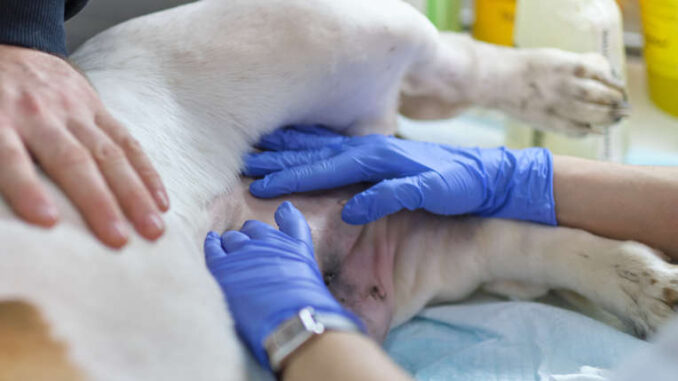
This article was updated on September 6th, 2023
Finding a lump on or around your dog’s private parts can be concerning for pet parents. In the case of lumps on the genitals, there are many possible causes, ranging from minor and easily treatable skin infections to benign or malignant cancers. Let’s explore some possible causes that can affect female and male dogs, starting with female dogs.
1. Common causes of lumps on a dog’s privates for female dogs
Hyperplasia and prolapse:
Vaginal hyperplasia is an increase in cells and tissue of the vaginal mucosa, resulting in enlargement.
What it looks like: See picture 1 on this graphic (warning, graphic images!)
In some cases, this can progress to vaginal prolapse, which occurs when part of the vagina that is normally on the inside extends outwards (like a sock being turned inside out). It appears as a round or donut-shaped pink mass, which is smooth and shiny at first, then begins to crack and dry.
Symptoms:
1. Swelling / enlargement of the vulva.
2. Discharge: thick or mucous-like discharge from the vaginal area.
3. Licking and discomfort: dogs will usually lick excessively at the area. The discomfort and irritation may also cause restlessness or agitation.
4. Urinary issues: rarely, it can interfere with urination.
5. Bleeding: Some dogs may experience minor bleeding from the swollen tissue.
These conditions occur due to hormone exposure, either during proestrus and estrus of an intact female’s heat cycle, or exposure to external hormones such as estrogen cream.
Vaginal hyperplasia should resolve when exposure to estrogen is removed (removing external sources, spaying the dog, or natural progression of the heat cycle). If it is not causing an issue, treatment may not be needed. However, if tissue is protruding from the vulva, it must be kept clean and moist, and an e-collar should be used to prevent licking and further trauma. Depending on the severity of the condition, your vet may clean and suture the tissue back in place. Relapse is common.
Vaginal and vulvar tumors
Tumors of the vagina and vulva are most commonly seen in unspayed dogs who have never given birth. Most are non-cancerous, including leiomyomas, fibroleiomyomas, fibromas, polyps, lipomas, sebaceous adenomas, fibrous histiocytomas, benign melanomas, myxomas, and myxofibromas; however malignant tumors such as transitional venereal tumors (discussed below) and others are possible.
What it looks like: See image of a vaginal mass on DrStephenBirchard’s blog post here.
Symptoms of vaginal and vulvar tumors may include:
– bleeding or discharge from the vulva,
– enlarged vulva,
– a visible mass,
– pain with urination and defecation,
– hematuria (bloody urine), and
– excessive licking of the genitals.
The mass itself may vary in appearance. Some are pedunculated (on a stalk) while others are found on the vaginal wall. They may be black, tan, pink, fleshy, or white in appearance. These masses often occur inside the vulva and then poke out.
Polyps are an especially common type of benign tumor that can be found in this location.
Most of these tumors are hormone-dependent, therefore spaying (surgically removing the ovaries and uterus) is an important part of treatment. The tumors themselves can also be removed, although complete excision may be difficult, given the location. In some cases, follow-up treatment with radiation is recommended.
2. Common causes of lumps on a dog’s privates for male dogs
Bulbis glandis
The bulbus glandis is a normal part of a male dog’s anatomy. The bulbus glandis is made up of erectile tissue, and when a male dog is excited, blood flows into the structures, causing engorgement and swelling.
What it looks like:
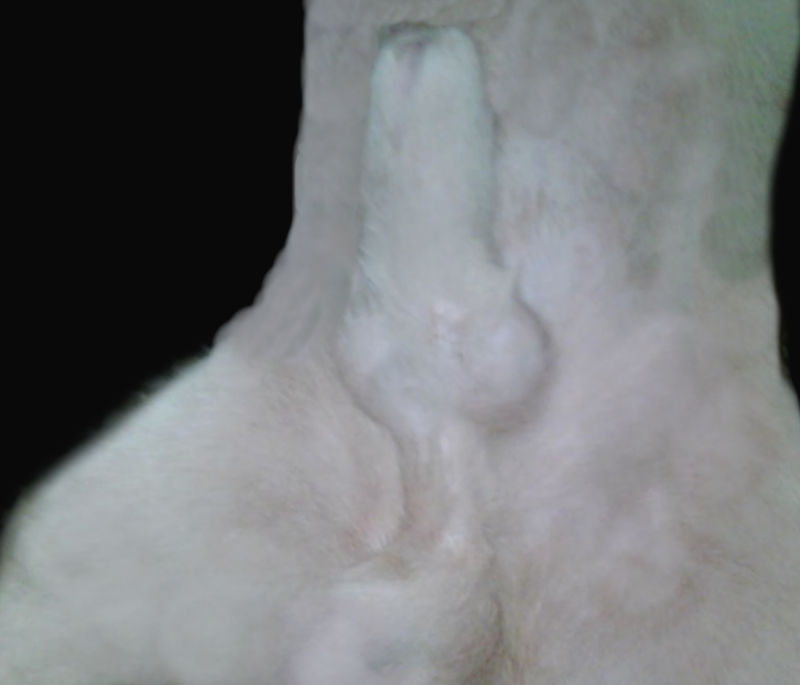
When engorged, the bulbis glandis appear as symmetrical, round, firm, swellings located on either side of the penis in both intact and neutered male dogs. See picture below or read our article about bulbus glandis (with more pictures).
Cryptorchidism (retained testicle)
What it looks like: See this image (first or last photo) showing a retained testicle in the inguinal canal, visible at the arrow.
A dog is considered a cryptorchid if one or both of their testicles fail to descend into the scrotum. In some cases, the retained testicle is in the abdomen, but in others it can be felt as a small movable lump under the skin alongside of the penis. Cryptorchids are more prone to developing testicular cancer or torsion; therefore, it is always recommended to neuter these dogs.
Testicular tumor or infection
What it looks like: The image here on Animal Surgical Center shows enlargement of the right testicle due to testicular cancer.
There are several types of testicular tumors, that are most common in older intact male dogs, especially those with cryptorchidism (retained testicles). The clinical signs include presence of a mass within the affected testicle, enlargement of the testicle, unevenly sized testicles, or swelling of the scrotum. These cancers have a low rate of metastasis (spread) and are generally treated by neutering (surgically removing the testicles). The testes can also become inflamed secondary to infection, leading to pain and swelling.
3. Lumps or bumps found in both male and female dogs
Transmissible venereal tumor
What it looks like: Image on JuniperPublishers (warning – graphic images).
Transmissible venereal tumors (TVTs) are a type of contagious cancer that affects dogs. This cancer is unique because it can be transmitted between dogs through direct contact, usually during mating. The tumors primarily affect the genital region of both male and female dogs, but can also occur in other areas such as the nose, mouth, or eyes. TVTs are most common in tropical and subtropical areas and in intact dogs.
Transmissible venereal tumors on the penis/prepuce or vulva may cause irregular thickening of the tissue, bruising, intermittent bleeding, discomfort, and excessive licking of the area. Growths located in the mouth are often cauliflower-like nodules that may ulcerate and bleed. They are generally diagnosed via cytology from a fine needle aspirate, in which cells are examined under the microscope.
TVTs usually remain localized to one area, although they can continue to grow and become bothersome if untreated. In rare cases, they can spread to other areas of the body, such as lymph nodes. Treatment options include chemotherapy, radiation, surgery, or a combination.
Pyoderma (skin infection)
What it looks like: The image below shows a dog with a skin infection on the abdomen and vulva:
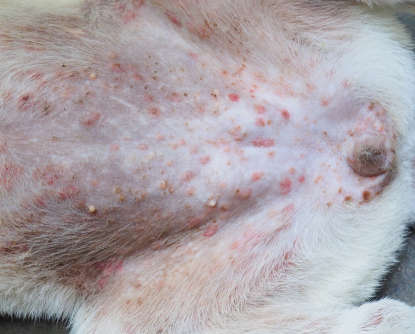
A skin infection can occur anywhere on a dog’s body, including on or around the genitals. Skin infections can cause itchy skin, hair loss, redness, pustules (small pimple-like bumps), and scabs. Many dogs who suffer from recurrent skin or ear infections have an underlying allergy. Dogs can be allergic to fleas, something in their diet (food allergy), or something in the environment (atopy). Contact dermatitis can also occur on a specific area of the body that is exposed to an irritant.
A urinary issue, such as a UTI, or an anatomical issue, such as recessed vulva, can also lead to excessive licking of the genitals and secondary infection.
Depending on the severity of the skin infection, treatment may include topical (shampoo or wipes) or oral antibiotics, anti-inflammatories, and pain medications. It is also important to address any potential allergies by using consistent flea prevention, medications to help control symptoms, or a hypoallergenic diet. View more pictures of pyoderma in dogs.
Skin cancer
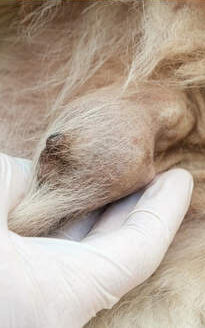
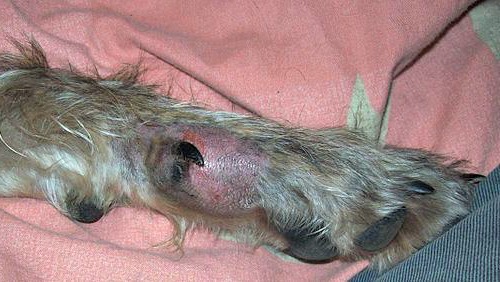
There are many different types of skin lesions, both benign and malignant, that can occur in dogs. These growths can occur anywhere on the skin, including on or around the genitals. Common benign lesions include skin tags, cysts, lipomas (fatty masses), histiocytomas, and sebaceous gland tumors. Common malignant tumors include squamous cell carcinoma, mast cell tumor, and malignant melanoma. You can review our page listing the most common lumps and bumps on dogs or view a complete list in the Merck Veterinary Manual. These lesions can vary in size, location, and appearance and should be evaluated by your vet.
Tick or bug bite

Ticks can often be mistaken for growths. They can appear tan or grey in color and become larger after taking a blood meal, but upon close examination, you may be able to see their eight small legs. Ticks can be removed at home or by your vet. Certain types of ticks can spread disease, such as Lyme. If you are concerned about ticks, discuss options for prevention with your vet. Bug bites may also cause a red bump which will often resolve with time.
Other
Other possible causes include hernias, enlarged lymph nodes, or wound/trauma.
Should I be worried if my dog develops a lump in its privates?
A lump on a dog’s privates can range from part of their normal anatomy to an easily treatable infection to a malignant cancer. It is important to see your vet for an exam, diagnostic testing, and treatment options.
Veterinarian visit or wait-and-see?
Anytime a pet parent notices a new lump or bump on their dog, I recommend that they get it checked by their vet. In many cases, they can perform a quick test to collect a sample of cells for evaluation under the microscope to help put your mind at ease.
In other cases, for example if an infection is present, they can prescribe appropriate medications. If the lump does turn out to be something more serious, it is always best to know sooner rather than later when treatments may be easier and more effective. At the very least, your vet can measure and note the lump in your dog’s medical record so that you can both continue to monitor it in the future.
Signs that you need to call the veterinarian right away
- A lump that is painful or bothersome for your dog
- A lump that is increasing rapidly in size
- A lump that is oozing discharge, blood, or has a foul odor
- A lump accompanied by other signs of illness such as fever, lethargy, bloody urine, straining to urinate or defecate, or loss of appetite
Will a vet be able to help over a video call?
It depends. In some cases, your vet may be able to reassure you that a lump on your dog’s privates is not concerning or something that may respond to simple treatment such as medicated wipes or shampoo. However, in most cases, they will need to perform a hands-on physical exam and diagnostic testing to determine the underlying cause and best treatment options for your pup.
Vet diagnostics for lumps and bumps
Your vet will start with a nose-to-tail physical exam and history. Additional testing may include:
- Cytology (fine needle aspirate) – Your vet can use a needle to collect a small sample of cells from the mass for evaluation under the microscope.
- Biopsy – Your vet may surgically remove part or all of a mass and submit it to a pathologist for evaluation. Depending on the size and location of the mass, this may be done under general anesthesia or sedation.
- Bloodwork – Bloodwork will help evaluate your dog’s overall health and major organ function.
- Urinalysis – Evaluating the urine helps provide information about kidney health and urinary tract issues, such as UTI.
- Staging – If your vet is concerned about the potential spread of cancer, they may recommend radiographs of the chest, an abdominal ultrasound, or other testing. Staging helps give vets and pet parents important information about if and where cancer has spread to guide treatment recommendations.
Treatment options
As discussed above, there are many different possible causes of lumps on a dog’s genitals, therefore, the recommended treatments will vary greatly. Possible treatments may include:
- Antibiotics – Topical and/or oral antibiotics are used to treat infection
- Surgery – For example surgical removal of a lump, repair of a hernia, or replacement of a prolapse
- Chemotherapy or radiation – For cancer, referral to a veterinary oncologist for chemotherapy or radiation may be an option
- E-collar – To prevent licking and further trauma
Disclaimer: This website's content is not a substitute for veterinary care. Always consult with your veterinarian for healthcare decisions. Read More.


Be the first to comment